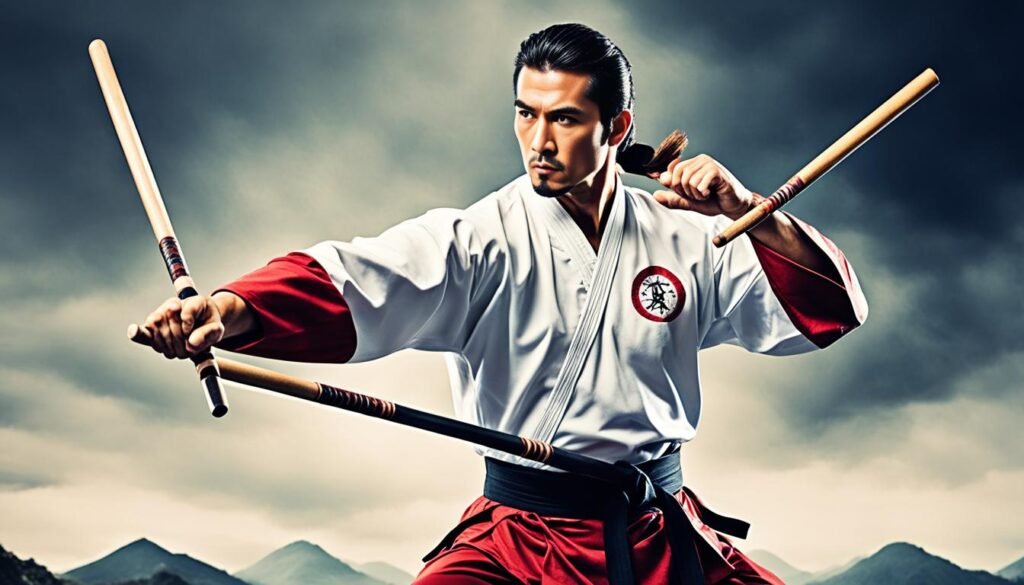The national martial art of the Philippines, arnis, has a centuries-old history, as you may not be aware.
Arnis is a traditional Filipino martial art that emphasizes weapon-based combat with sticks, knives, bladed weapons, and homemade weapons. It is often referred to as kali or eskrima/escrima. It is a very successful self-defense method that blends real-world fighting tactics with martial arts skills.
Arnis is well known throughout the world for its distinctive stick fighting methods and fluid movements. Notable martial artists like Bruce Lee and Dan Inosanto have also adopted the art form, adding to its already good reputation.
Let’s examine arnis’s background, methods, and cultural relevance in more detail.
Table of Contents
Key Takeaways
- Arnis is the national martial art of the Philippines.
- It emphasizes weapon-based fighting, particularly with sticks.
- Arnis incorporates both offense and defense techniques.
- The art form has a deep cultural significance in Filipino society.
- Arnis has gained global recognition and the admiration of famous martial artists.
History and Development of Arnis
The history of arnis can be traced back to the indigenous fighting techniques of pre-Hispanic Filipino tribes and kingdoms. These ancient martial arts were practiced and developed over centuries, shaping the foundation of what would later become the modern art of arnis.
However, the development of arnis as we know it today was influenced by the arrival of Spanish colonizers in the Philippines. During the Spanish colonial period, the Spaniards observed and documented the native martial arts practiced by the Filipinos.
Despite attempts by the Spanish to suppress native traditions, arnis managed to survive and evolve. The prohibition of arnis by the Spanish only fueled its secrecy and preservation within Filipino communities.
Over time, arnis underwent further development as a result of interactions with other cultures. In the 20th century, exposure to Japanese martial arts and American military training brought new perspectives and techniques to arnis.
Following the Philippines’ independence, arnis gained recognition and popularity, leading to its official declaration as the national martial art and sport of the Philippines in 2009.
Arnis holds immense cultural significance in Filipino society. It represents a rich heritage of indigenous martial arts and symbolizes the resilience and strength of the Filipino people. The art of arnis reflects the historical struggles and triumphs of the Philippines, making it an integral part of the country’s history and identity.
Influences on the Development of Arnis
| Influences | Description |
|---|---|
| Pre-Hispanic Filipino Tribes and Kingdoms | Indigenous fighting techniques of Filipino tribes provided the foundation for arnis. |
| Spanish Colonization | Observation and documentation of native martial arts by Spanish colonizers influenced the development of arnis. |
| Contact with Japan | Exposure to Japanese martial arts introduced new perspectives and techniques to arnis. |
| Contact with the United States | American military training contributed to the evolution of arnis. |
Techniques and Practice of Arnis
Arnis is primarily a weapon-based martial art, with a strong emphasis on stick fighting. Practitioners of Arnis utilize a variety of weapons, including sticks, knives, and improvised weapons. The main tool used in Arnis is a baton-like cane made of rattan, although other materials such as hardwood, high-impact plastics, aluminum, and metal can also be utilized.
In Arnis, learners are trained in a combination of striking, thrusting, and parrying techniques for both offensive and defensive maneuvers. These techniques are specifically designed to be effective in weapon-based combat situations. However, Arnis also incorporates empty-hand techniques, known as mano mano, which focuses on applying pressure, joint locks, and disarming opponents. The movements of mano mano are directly derived from the weapon techniques of Arnis, ensuring a seamless integration of both weapon-based and empty-hand strategies.
Arnis is taught and practiced in various forms, including choreographed performances called anyo and combative matches known as leban. Anyo involves the showcasing of intricate and fluid movements, showcasing the practitioner’s mastery of Arnis techniques. Leban, on the other hand, is a realistic and dynamic sparring session that puts the practitioner’s skills to the test.
With its emphasis on weapon-based fighting, stick and dagger techniques, as well as empty-hand techniques, Arnis is a comprehensive martial art that provides practitioners with a well-rounded skill set for self-defense and combat. It is a powerful and effective discipline that has been passed down through generations, embodying the rich cultural heritage of the Philippines.
FAQ
What is arnis?
Arnis is a national martial art of the Philippines that emphasizes weapon-based fighting with sticks, knives, bladed weapons, and improvised weapons. It also incorporates “open hand” techniques without weapons.
Where does the term “arnis” come from?
The term “arnis” comes from the Old Spanish word “arnés,” meaning “armor.” It is believed to have derived from the armor costumes used in traditional stage plays in the Philippines.
Why was Arnis banned?
Arnis was banned during Spanish colonial rule in the Philippines, particularly for native fighting arts involving bladed weapons. The ban, enforced with severe penalties, led practitioners to adapt using rattan sticks to continue their martial arts practice.
Is Arnis effective in a street fight?
Arnis is considered effective in street fights, emphasizing practical self-defense techniques, especially against armed attackers. Filipino Martial Arts, including Arnis, are known for real-world effectiveness.
Why is Arnis unique?
Arnis is unique as the national martial art of the Philippines, showcasing cultural and historical significance. Its use of rattan sticks, adaptation during the Spanish ban, and evolution into a sport blend tradition with modern competition, making it a versatile and distinctive martial art form.

